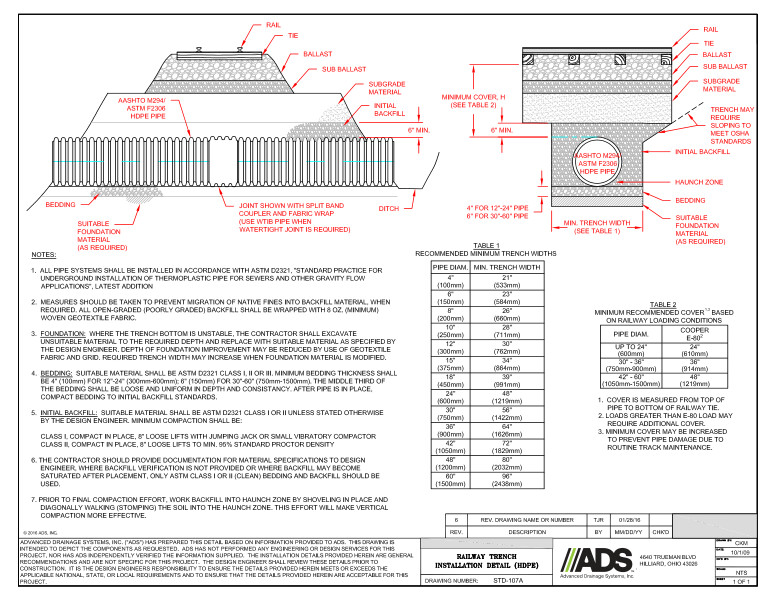107A Railway Trench Installation Detail (HDPE)
Filename:
107A Railway Trench Installation Detail (HDPE).pdf

This document is the drawing for the 107A Railway Trench Installation Detail (HDPE), showing how to install HDPE pipe under a railway..
The 107A Railway Trench Installation provides 2 drawings, both front and side view. The drawings illustrate installation from the top, starting with the rails, the ties, the ballast and the sub ballast. Underneath that is the subgrade material with the initial backfill. The HDPE pipe needs to follow the specifications of AASHTO M294 / ASTMF2306. The side view drawing indicates that the trench may require sloping to meet OSHA standards. Please refer to the drawing bedding measurements and minimum trench widths.
This drawing includes installation notes. Note 1 says that all pipe systems shall be installed in accordance with ASTM D2321, “Standard Practice for Underground Installation of Thermoplastic Pipe for Sewers and other Gravity Flow Applications.” Note 2 says measures should be taken to prevent migration of native fines into backfill material, when required. All open-graded (poorly graded) backfill shall be wrapped with a minimum 8 oz. woven geotextile fabric. Note 3 is about the foundation. Where the trench bottom is unstable, the contractor will excavate unsuitable material to the required depth and replace it with suitable material as specified. Note 4 covers bedding requirements. Suitable materials need to be ASTM Class I, II, or III. Minimum bedding thickness for 4” (100mm) is 12”-24” (300mm-600mm). Minimum bedding thickness for 6” (150mm) for 30”-60” (750mm-1500mm). The middle third of the bedding shall be loose and uniform in depth and consistency. See the drawing for more information.
Two tables are also provided for reference. Table 1 is the Recommended Minimum Trench Widths with Pipe Diameters and Minimum Trench Widths. Table 2 is the Minimum Recommended Cover Based on Railway Loading Conditions with Pipe Diameter and Cover. The cover is measured from top of the pipe to the bottom of the railway tie. Loads greater than E-80 load may require additional cover. The minimum cover may be increased to prevent pipe damage due to routine railway track maintenance.
